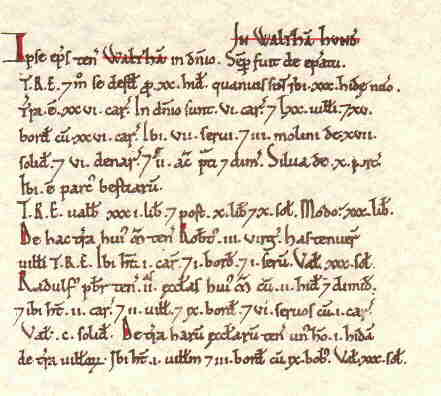 The entry for est myll, which is
shown here, reads:
The entry for est myll, which is
shown here, reads:
 The entry for est myll, which is
shown here, reads:
The entry for est myll, which is
shown here, reads:
"The Bishop himself holds WALTHAM in
demesne. It always belonged to the bishopric (fuit de episcopatu). T.R.E.
it was, as now, assessed at 20 hides; although there be there 30 hides in
number. There is land for 26 ploughs. In the demesne are 6 ploughs; and
(there are) 70 villeins and 15 bordars with 26 ploughs.
There are 7 serfs, and 3 mills worth 7 shillings and 6 pence; and 2 1/4
acres of meadow. There is wood(land) worth 10 swine. There is (also) a park
for beasts(of the chase). T.R.E. it was worth 31 pounds, and afterwards
30 pounds 10 shillings. It is now worth 30 pounds. Of this land of this
manor, Robert holds 3 virgates: villeins held them T.R.E. There he has 1
plough and 1 bordar and 1 serf. it is worth 30 shillings. Ralf the priest
holds the 2 churches of this manor, with 2 hides; and there he has 2 ploughs
(in the demesne); and (there are) 2 villeins and 9 bordars and 7 serfs with
1 plough. It is worth 100 shillings. Of the land belonging to these churches
1 man hoIds 1 hide of the land occupied by the villeins (terra villanorum);
and there he has 1 villein and 3 bordars with 9 oxen: it is worth 30 shillings."
It is interesting that the valuation of the estate is low. This is probably because in 1001 A.D. Waltham was destroyed by the Danes, and it is likely that it had not fully recovered.